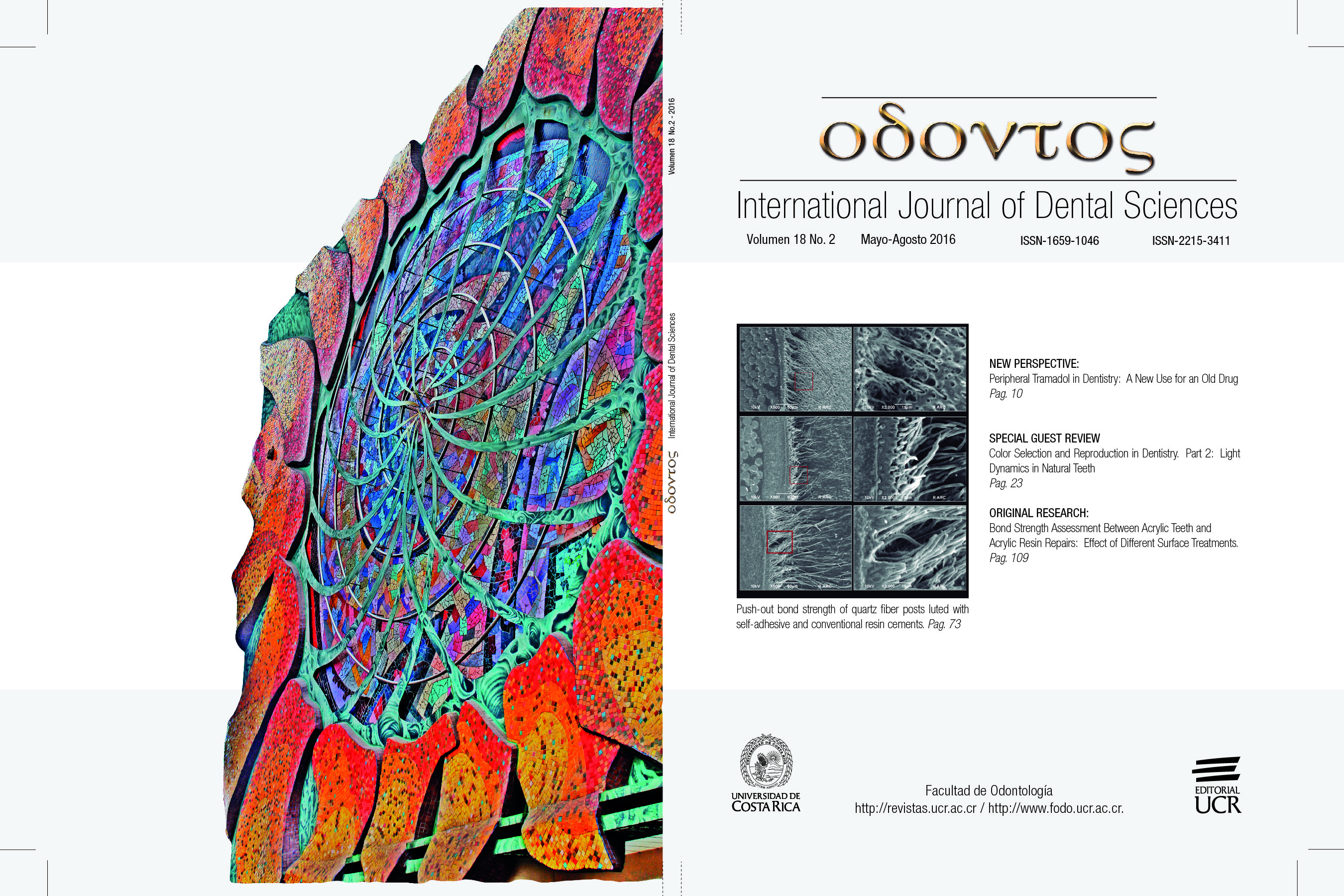Abstract
The aim of this study was to evaluate the influence of the resin cement on push-out bond strength of quartz fiber posts to intraradicular dentin. Fifty-six single-rooted human teeth were selected. After removing the crown, roots were endodontically treated and the dowel spaces were prepared with # 2 post drills of DT Ligth® SL Post System (VDW®). The specimens were randomly divided into four groups (n = 14). Group 1: RelyX™ Unicem (3M ESPE), Group 2: Clearfil ™ SA Cement (Kuraray), Group 3: Bifix SE (Voco), and G4 RelyX™ ARC (3M ESPE). After 24 h, 12 specimens of each group were sectioned in 6 slices with 1 mm of thickness, two of each radicular third. The push-out test was conducted in an Instron machine at 0.5 mm/min. Data were submitted to ANOVA and Bonferroni test. Fractured specimens were observed at 25X to evaluate the types of failures. Two specimens of each group were processed for SEM evaluation. The Mean values (MPa) for groups 1, 2, 3 and 4 were respectively: 11.06, 8.85, 8.37 and 13.36. All experimental groups showed higher values of resistance in the cervical third, while the lowest were in the apical third. Adhesive failures between cement and dentin (46.87 %) prevailed, followed by mixed failures (45.15 %). SEM photomicrographs illustrating the interface formed between the self-adhesive resin cements and dentin showed an interface without the formation of a hybrid layer. G4 showed the formation of a thick and homogeneous hybrid layer with resin tags. The conventional resin cement associated with a three-step adhesive system displayed the higher bond strength to intraradicular dentin, when compared to the different self-adhesive resin cements.
References
Bitter K., Paris S., Pfuertner C., Neumann K., Kielbassa A. M. Morphological and bond strength evaluation of different resin cements to root dentin. Eur J Oral Sci, 2009; 117; 326-333.
Schwartz R. S., Robbins J. W. Post placement and restoration of endodontically treated teeth: a literature review. J. Endod, 2004; 30: 289–301.
Goracci C., Sadek F. T., Fabianelli A., Tay F. R., Ferrari M. Evaluation of the adhesion of fiber posts to intraradicular dentin. Oper Dent, 2005; 30: 627–635.
Goracci C., Tavares A. U., Fabianelli A., Monticelli F., Raffaelli O., Cardoso P. C., Tay F., Ferrari M. The adhesion between fiber posts and root canal walls: comparison between microtensile and push-out bond strength measurements. Eur J. Oral Sci, 2004; 112: 353–361.
Bitter K., Meyer-Lueckel H., Priehn K., Kanjuparambil J., Neumann K., Kielbassa A. M. Effects of luting agent and thermocycling on bond strengths to root canal dentine. Int Endod J, 2006; 39: 809–818.
Bouillaguet S., Troesch S., Wataha J. C., Krejci I., Meyer J. M., Pashley D. H. Microtensile bond strength between adhesive cements and root canal dentin. Dent Mater, 2003; 19: 199–205.
De Durao Mauricio P. J., Gonzalez-Lopez S., Aguilar-Mendoza J. A., Felix S., Gonzalez-Rodriguez M. P. Comparison of regional bond strength in root thirds among fiber-reinforced posts luted with different cements. J. Biomed Mater Res B Appl Biomater, 2007; 83: 364–372.
Ferrari M. Fiber posts and endodontically treated teeth: a compendium of scientific and clinical perspectives. Wendywood: Modern Dentistry Media; 2008. p.85-93.
Monticelli F., Osorio R., Mazitelli C., Ferrari M., Toledano M. Limited decalcification/diffusion of self-adhesive cements into dentin. J. Dent Res, 2008; 87: 974-979.
De Munck J., Vargas M., Van Landuyt K., Hikita K., Lambrechts P., Van Meerbeek B. (2004). Bonding of an auto-adhesive luting material to enamel and dentin. Dent Mater; 20: 963-971.
Ibarra G., Johnson G. H., Geurtsen W., Vargas M. A. (2007). Microleakage of porcelain veneer restorations bonded to enamel and dentin with a new self-adhesive resin-based dental cement. Dent Mater; 23:218-225.
Mazzitelli C., Monticelli F. Evaluation of the push-out Bond strenght of self-adhesive resin cements to fiber posts. International dentistry, 2010; 11: p. 54-60.
Perdigao J., Van Meerbeek B., Lopes M. M., Ambrose W. W. The effect of a re-wetting agent on dentin bonding. Dent Mater, 1999;15: 282–95.
Wang V. et al. Effect of two fiber post types and two luting cement systems on regional post retention using the push-out test. Dent Mater, 2008; 3: 372-7.
Kececi A. et al. Micro push-out bond strenghts of four fiber-reinforced composite post systems and 2 luting materials. Oral Surg. Oral Med. Oral Pathol. Oral Radiol. Endod., 2008; 1: 121-8.
Ferrari M. et al. Influence of luting material filler content on post cementation. J. Dent. Res, 2009; 10: 951-6.
Ferrari M., Vichi A., Grandini S. Efficacy of different adhesive techniques on bonding to root canal walls an SEM investigation. Dent Mater, 2001; 5: 422-29.
Ferrari M et al. Bonding to root canal: Structural characteristics of the substrate. Am J. Dent, 2000; 5: 255-60.
Bitter K. et al. Bond strengths of resin cements to fiber-reinforced composite posts. Am J. Dent, 2006; 2: 138-42.
Ferrari, M. et al. Influence of microbrush on efficacy of bonding into root canals. Am J Dent, 2002; 15: 227-31.
Radovic I. et al. Coupling of composite resin cements to Quartz fiber posts: a comparison of industrial and chairside treatments of the post surface. J Adhes. Dent, 2008; 1:57-66.
GERTH, H.U. et al. Chemical analysis and bonding reaction of RelyX Unicem and Bifix composites--a comparative study. Dent Mater., Washington, v. 22, n.10, p. 934-41, Oct. 2006.
Al-Assaf K., Chakmakchi M., Palaghias G., Karanika-Kouma A., Eliades G. Interfacial characteristics of adhesive luting resins and composites with dentine. Dent Mater 2007; 23: 829–839.
De Munck J., Vargas M., Van Landuyt K., Hikita K., Lambrechts P., VanMeerbeek B. Bonding of an auto-adhesive luting material to enamel and dentin. Dent Mater 2004; 20: 963–971.
Saskalauskaite E., Tam L. E., Mccomb D. Flexural strength, elastic modulus, and pH profile of self-etch resin luting cements. J Prosthodont 2008; 17: 262–268.
Zicari F., Couthino E., De Munck J., Poitevin A., Scotti R., Naert I., Van Meerbeek B. Bonding effectiveness and sealing ability of fiber-post bonding. Dent Mater 2008; 24: 967–977.

